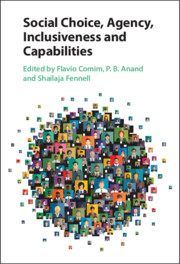Book contents
- Social Choice, Agency, Inclusiveness and Capabilities
- Social Choice, Agency, Inclusiveness and Capabilities
- Copyright page
- Contents
- Figures
- Tables
- Contributors
- Preface and Acknowledgements
- 1 Introduction: social choice, agency, inclusiveness and capabilities
- Part I Social Choice and Capabilities
- Part II Inclusiveness, Social and Individual Agency
- 7 In defence of inclusiveness
- 8 Exploring Sen on self-interest and commitment
- 9 Incorporating an emotional dimension in the capability approach
- 10 Sufficiency re-examined
- 11 Adaptive preferences versus internalization in deprivation
- 12 Enriching agency in the capability approach through social theory contributions
- 13 Creativity and capabilities
- Part III Social Choice and Capabilities in Action
- Index
- References
9 - Incorporating an emotional dimension in the capability approach
from Part II - Inclusiveness, Social and Individual Agency
Published online by Cambridge University Press: 28 March 2024
- Social Choice, Agency, Inclusiveness and Capabilities
- Social Choice, Agency, Inclusiveness and Capabilities
- Copyright page
- Contents
- Figures
- Tables
- Contributors
- Preface and Acknowledgements
- 1 Introduction: social choice, agency, inclusiveness and capabilities
- Part I Social Choice and Capabilities
- Part II Inclusiveness, Social and Individual Agency
- 7 In defence of inclusiveness
- 8 Exploring Sen on self-interest and commitment
- 9 Incorporating an emotional dimension in the capability approach
- 10 Sufficiency re-examined
- 11 Adaptive preferences versus internalization in deprivation
- 12 Enriching agency in the capability approach through social theory contributions
- 13 Creativity and capabilities
- Part III Social Choice and Capabilities in Action
- Index
- References
Summary
This chapter makes the case for a greater inclusion of emotional factors in the CA, arguing that including an emotional dimension does not exclude rational calculation, but can be incorporated into a mixed approach. The mixture will be influenced by the context of the research; some contexts will appear to be less ‘emotional’ than others, but emotional aspects cannot be excluded from any CA research context. The argument is developed to identify five ways in which emotions may enter into CA research, ranging from being an independent influence, through positive and negative influences on capability development and expression as functionings. Moving towards social expressions in the CA, the chapter then explores how all human communication has an emotional element and how power relationships have an essential emotional dimension, and are fundamentally disempowering for many people. This disempowerment may manifest itself in negative emotions rather than rationally justifiable actions of resistance, leading to the need to question the assumption of public policies as benign, no matter how well intentioned, if the targets of these policies have had their rational agency denied.
- Type
- Chapter
- Information
- Social Choice, Agency, Inclusiveness and Capabilities , pp. 202 - 221Publisher: Cambridge University PressPrint publication year: 2024

